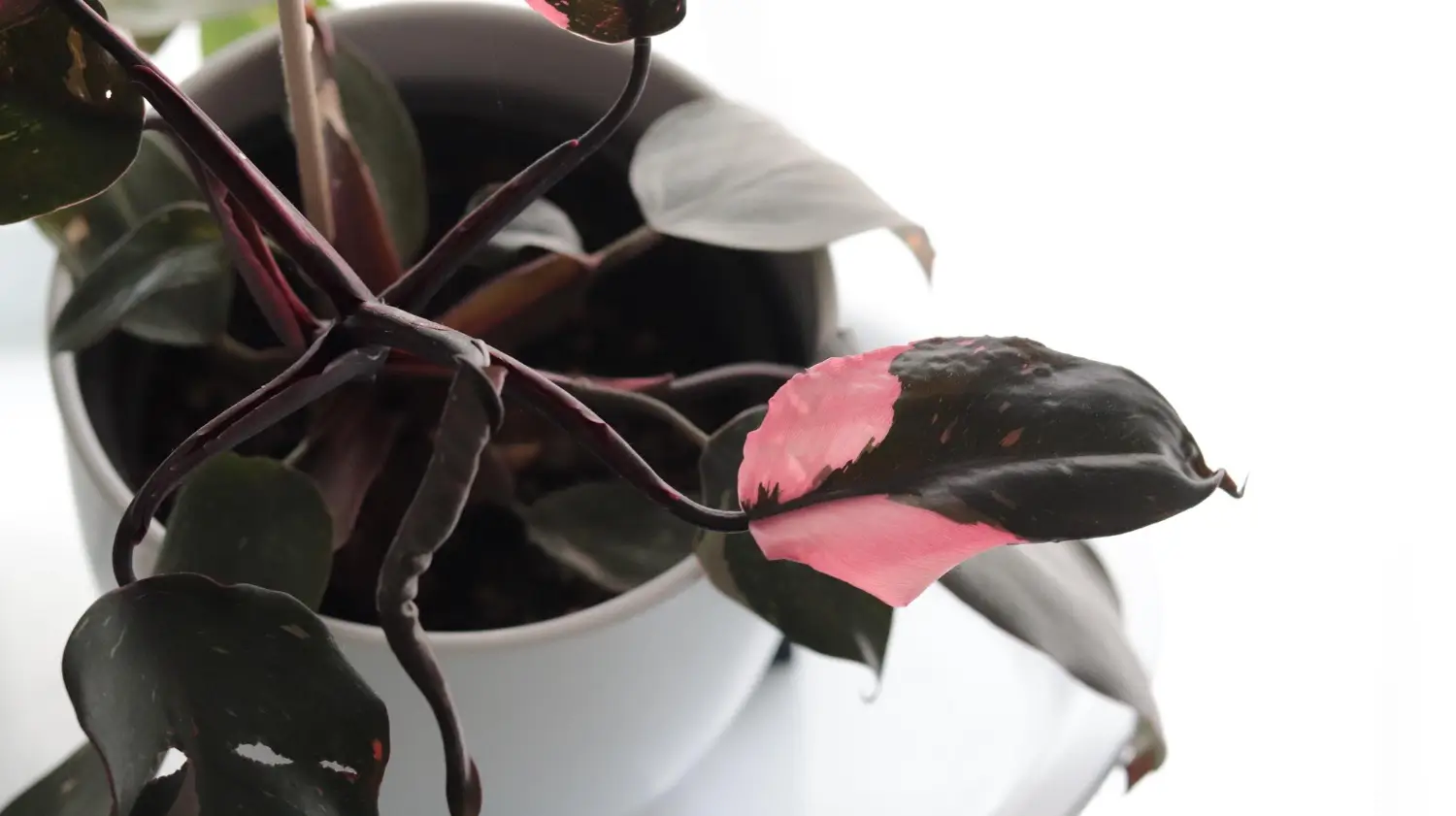
August 24, 2025

Tropical houseplants they are a gorgeous addition to any room inside! They have a stunning foliage appearance and are great for indoor planting. But many tropical plants that feature vivid colors and patterns can be hard to take care of because of their requirement for constant light and temperature changes. So, gardeners looking for a pretty houseplant that can grow well with minimal care can opt for the Philodendron Pink Princess plant.
This beautiful plant has dark green heart-shaped leaves with bright pink patches. Although the pink on the plant can range from bold streaks, small blotches, or even cover whole leaves, it definitely makes this a really special plant. It's pink and dark green coloring stirs up a combination that makes it a hot houseplant indeed, one beloved in the plant world.
It is a popular and easy-to-growhouseplant that provides yearly greenery. Growycles can be used to aid growers in deciding which techniques are best for plant health and development.
The Philodendron Pink Princess (Philodendron erubescens) is a beautiful, tropical plant known for its striking pink and dark green leaves. It’s a member of the Araceae family, making it a close cousin to houseplants such as the Monstera and Anthurium.
Growth Habit: Philodendron Pink Princess is a climbing, evergreen tropical plant that is native to the rainforests of Central and South America. In its native habitat, it climbs a tree with its aerial roots, but it can also grow on the ground.
Leaves:
Stems: The stems are strong and have a reddish or burgundy color. Small nodes along the stems produce aerial roots that help the plant climb and absorb moisture.
Flowers: Like other Philodendrons, this plant produces flowers typical of the Araceae family. The flower includes a spathe (a modified leaf) that wraps around a spadix (a fleshy spike with tiny flowers). However, flowering rarely happens indoors because the conditions are not ideal.
A popular houseplant, it has a number of benefits and is adored by plant lovers. Read on for the key benefits of planting these beautiful flowers:
Great Conversation Starter: It's not every day you come across a houseplant that is just as unique as you. Other plant enthusiasts or guests are drawn to admire its unusual beauty, which can lead to some fun, little chats.
Here are some common variations or closely related plants often associated with the Pink Princess:
Type/Variation | Description | Key Features |
|---|---|---|
Philodendron Pink Princess | The original and most popular variety with natural pink and green variegation. | Heart-shaped leaves with bubblegum pink patches on dark green, glossy foliage. |
Philodendron Pink Congo | A related plant is often sold as "pink," but its pink color is artificially induced. | Leaves appear solid pink at first but fade back to green over time. |
Philodendron White Princess | A variegated version featuring white and green instead of pink. | Leaves have white splotches and streaks with a similar shape and size. |
Philodendron Red Emerald | A non-variegated Philodendron erubescens with dark green and reddish stems. | Lush green leaves and striking red-colored stems. |
Philodendron Pink Lady | A less common variation with softer pink hues and more subtle variegation. | Leaves display lighter pink variegation compared to the Pink Princess. |
Philodendron Strawberry Shake | A rare cultivar with a mix of pink, cream, and green variegation. | Features streaks of pink, cream, and green in a marbled pattern. |
Philodendron Black Cherry | A rare variant with dark, almost black leaves and faint pink or burgundy. | Deep dark foliage with light pink hints offers a unique contrast. |
It is a beautiful and unique plant known for its pink and green variegated leaves. Here is a complete care guide of Philodendron Pink Princess to help it thrive:
This plant loves to be in the sun, but in indirect sunlight only. Good light is also necessary to retain its pink variegation, an unusual and special thing.
Watering the Pink Princess can be a bit tricky. Both overwatering and underwatering can become problems.
The Plant likes a humid space, its natural habitat is the tropical forest. High humidity maintains its leaves healthy and glossy.
The Pink Princess requires a fast-draining, highly nutritious soil mix. Overwatering issues such as root rot are prevented by the right soil.
The Pink Princess likes it warm, similar to a tropical location.
Healthy watering will ensure a healthy plant, and regular decapitation stimulates growth and variegation.
Pruning keeps the Pink Princess tidy, encourages bushy growth, and evens out the variegation.
Repotting enables your plant to grow bigger and provides fresh soil.
Keep your plant in bright, indirect light to preserve its signature pink variegation—avoid direct sun, which can scorch leaves. Water only when the topsoil is dry, allowing the soil to slightly dry out between waterings to prevent root rot.
Maintain humidity above 60% using pebble trays, humidifiers, or grouping plants. Keep temperatures steady between 65–85°F (18–29°C) and shield from cold drafts. Use a well-draining mix with peat moss, perlite, and orchid bark.
Fertilize monthly during spring and summer at half strength. Trim green or damaged leaves to encourage pink growth and maintain shape. Repot every 1–2 years into a slightly larger pot with drainage. Propagate with stem cuttings containing a node, and always keep an eye out for pests like spider mites or aphids—treat with neem oil if needed.
The propagation of Philodendron Pink Princess can help maintain the balanced growth of plants. The propagation process is usually done by two different methods, such as
There are a few issues that you might run into with your Philodendron princess, which may be harming your plant. Here are a few of them.
It typically occurs when the plant has not been receiving enough sun, causing it to lose variegation. It's necessary to verify this soil ASAP, because if it gets too dry, it can strip the plant of variegation forever. To do this, gardeners must set a plant in bright, indirect sunlight for correct exposure.
The plant generally gets root rot, which makes the leaves turn yellow, when you overwater the plant. But to correct this, gardeners must test the soil for moisture, and if it is too wet, then wait until it dries. In addition, if you have to repot, then do so as they might not have the right drainage system in an old pot.
If your plant isn’t receiving sufficient humidity, it could be the cause of your leaves turning brown. But this is not a solution, as it is not reversible. Thus, in the future, gardeners should mist their leaves periodically or use a humidifier to keep them from browning.
This shedding of leaves generally occurs for various reasons, including improper watering, temperature changes (sudden, enormous heat), or poor light. Therefore, gardeners should rapidly shift the spot to bright, indirect light and keep it at a steady temperature. You would also want to make sure you’re watering enough, not too much, or not too little.
The Philodendron Pink Princess is a lovely houseplant with dark green and pink leaves and is extra special. This is great for indoors to add a little charm. Its colorful mix of blooms and low-water requirements make it attractive to gardeners. With proper care, it can produce healthier and fuller leaves. Growcycle is giving gardeners everything they need to care for tropical houseplants.
Disclaimer: This material is for informational purposes only and should not be relied on for legal, medical, financial, or any other form of professional advice.
The Philodendron Pink Princess is considered expensive due to its rarity, striking pink variegation, and slow propagation process. These factors contribute to its high demand and limited availability.
This plant requires moderate care. It thrives in bright, indirect sunlight, consistent humidity, and proper watering. However, it can be sensitive to sudden changes in its environment.
A lack of adequate light is the most common reason. To maintain its pink variegation, place the plant in a location with bright, indirect light. Insufficient lighting can cause it to revert to mostly green leaves.